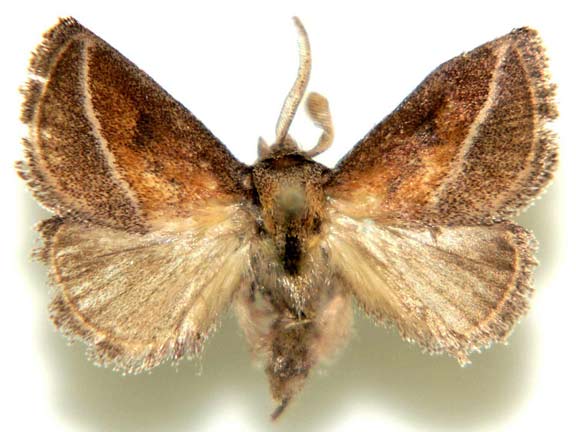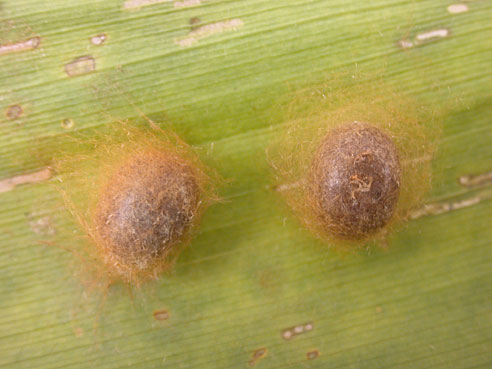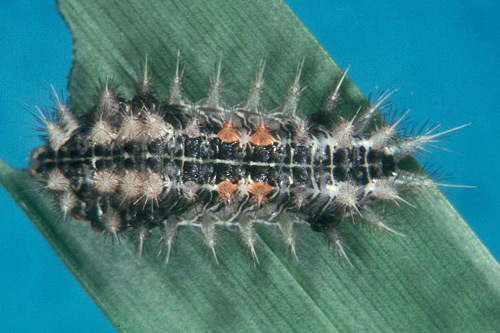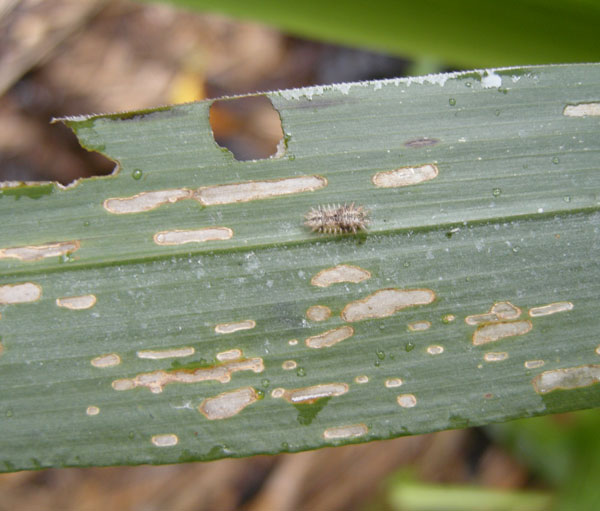Nettle Caterpillar
|
adult male (left) and female (right); Photo courtesy of Hawaii Department of Agriculture |
|
adult male; Photo by John Heppner, FDACS-DPI |
|
first instar larvae; Photo courtesy of Hawaii Department of Agriculture |
|
eggs; Photo courtesy of Hawaii Department of Agriculture |
|
caterpillars and black frass on palm leaf; Photo by Scot Nelson, University of Hawaii at Manoa |
|
larva, lateral view; Photo courtesy of Hawaii Department of Agriculture |
|
cocoons; Photo courtesy of Hawaii Department of Agriculture |
|
late instar larva, dorsal view; Photo courtesy of Hawaii Department of Agriculture |
|
windowing damage to palm leaf caused by early instar nettle caterpillars; Photo courtesy of Hawaii Department of Agriculture |
|
nettle caterpillar damage on coconut palm; Photo courtesy of Hawaii Department of Agriculture |
Scientific name
Darna pallivitta Moore
Family
Limacodidae
Description
Adults: Length 1.3 cm, females usually larger than males; forewing is divided by a white diagnonal marking with the upper portion rust-colored and lower portion lighter brown; hindwing uniformly light brown; male antennae bipectinatebipectinate:
feathery, with branches coming out of both sides of the main axis (generally applied to antennae)
, female antennae filiformfiliform:
threadlike, slender, and of nearly equal diameter throughout, with all segments of nearly equal size
. Adults do not feed.
Eggs: Flattened, transparent ovals, 0.8 x 1.6 mm in size; appearing as glassy sheen on leaf surface that is easily overlooked. Deposited in small clusters, a line, or singly, usually on undersides of older leaves.
Larvae: Length up to 2.5 cm; color white to light gray; two rows of spines, marbled with black and white on light grey; dark longitudinal stripe down the back; retractile yellow head; small thoracic legs.
Cocoons: Female cocoon 8.45 x 6.56 mm; male cocoon 7.88 x 6.42 mm; bean-shaped; light brown in color, covered with coarse silk.
Diagnostic features
Adult: Forewing orange brown with white line from apex to middle; male antennae bipectinatebipectinate:
feathery, with branches coming out of both sides of the main axis (generally applied to antennae)
to apex, female antennae filiformfiliform:
threadlike, slender, and of nearly equal diameter throughout, with all segments of nearly equal size
.
Larvae: Covered with many rows of stinging spines, vary from white to light gray with dark longitudinal stripe down the back.
Distribution
Native: Borneo, China, Java, Malaysia (peninsular), Taiwan, and Thailand
Introduced: Hawaii and Japan
Hosts
Palms: includes Areca, Caryota, Chrysalidocarpus, Cocos, Phoenix, Rhapis, and Veitchia
Other: reproduces on a variety of plants, but feeds on many more
Additional comments
This caterpillar can cause significant defoliation. When present, the larvae deposit a distinctive green or black frassfrass:
the mixture of plant and fecal material left behind by many phytophagous insects
on the leaves.
Stinging spines can cause severe burning and itching of the skin. Noticeable swelling may occur and welts may form that can last for several days followed by a persistent rash lasting for weeks. Individuals with severe symptoms, such as difficulty breathing, should seek medical assistance.


,-female-(r).jpg)









